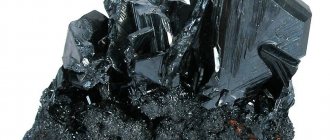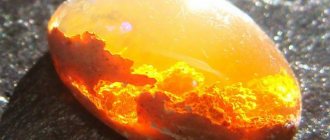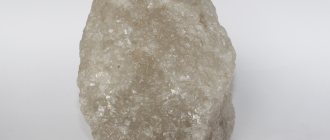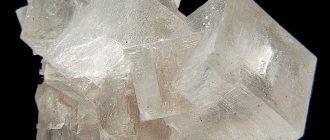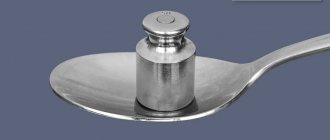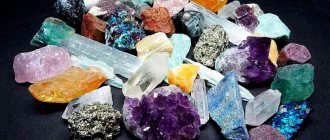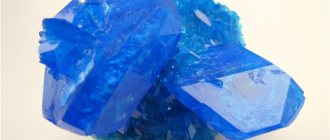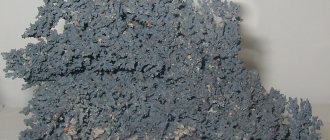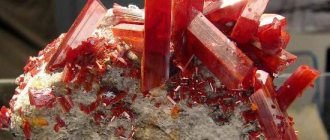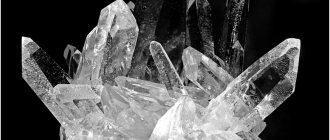Group
Rock salt , Steinsalz (often also used to denote a rock consisting of halite), table salt - Kochsalz, sodium chloride, lake salt, self-settling salt , ice salt, blue salt (for blue halite), partly hairy salt - Faserzalz, β-halite - β-halite (Panike, 1933), saltspar - saltspar (Murzaev, 1941) - coarse-crystalline sediments. Crackling salt (Lebedev, Textbook of Mineralogy, 1907) - salt containing inclusions of gases, crackling when dissolved, falcon salt (Lebedev, ibid.) - local name used in Yakutia, martinsite - martinsite, described by Karsten (1845) - halite from Stasfurt with an admixture of MgSO4, natrikalite (Adam, 1869) - a mixture of halite and sylvite from Vesuvius, kallar (Dana, 1892) - impure salt from India, Zuber - halopelitic rock cemented with halite. Guantajayite - halite containing up to 11% silver, may be a mixture (Raimondi, 1876).
The English name of the mineral Halite is Halite
Crystallographic characteristics
Syngony. Cubic (3L44L36L29PC).
Class. Hexoctahedral.
Crystal structure
In the structure, Na and Cl atoms alternate uniformly at the sites of a simple (primitive) cubic lattice with a0 = 2.82 A; in view of the difference between Na and Cl, we need to talk about two face-centered lattices (Na and Cl) with a0 = 5.64 A, inserted into one another. Since the Cl ionic radius is significantly larger than the Na radius, the structure can be represented as a dense cubic packing of Cl atoms; all octahedral voids contain Na atoms. The coordination number of both Cl and Na is 6, the coordination polyhedron is an octahedron. Perfect cleavage along the faces of the cube is due to the fact that these planes are uniformly populated with cations and anions and are therefore electrically neutral. The ionic type of bond predominates.
Main forms: Main forms: a (100), o (111).
Blue halite Artemovskoe
Gray
Another name is Celtic. It is a type of sea salt obtained from the bottom of the tidal flats on the French coast. The product is enriched with a small percentage of minerals, including calcium and magnesium, and has high humidity. If you touch the crystals, they will seem slightly damp. In cooking, the variety is used for salting fish and meat dishes, and baking.
Form of being in nature
The appearance of crystals. The crystals are cubic, very rarely octahedral, sometimes reaching significant sizes. Cubic crystals of NaCl are formed from neutral solutions, octahedral crystals are formed from active, acidic or alkaline solutions. Very characteristic skeletal formations are fragile, cloudy white hollow pyramids—“boats”—floating on the surface of the brine with the tip down; the walls of the boats are usually stepped, often bearing a scar or “suture” formed as a result of growth from the ribs along the walls towards each other. The boats are usually zonal as a result of the uneven arrangement of mother liquor inclusions, which usually form chains parallel to the faces of the cube. Often the boats are deformed and grow together. Skeletal crystals with a herringbone structure, the so-called “salt teeth,” are also found. Their peculiar appearance is due to the uneven distribution of inclusions, which is caused by a change in the growth rate under conditions of uneven supply of substances when the rate of brine evaporation changes. Cubic crystals with funnel-shaped and concave faces are known. Sometimes the crystals are curved or have a distorted (rhombohedral or lamellar) shape due to growth under directed pressure conditions. Lenticular crystals grown in the clay were also noted, oriented with a third-order axis perpendicular to the layering of the clay. The edges of the crystals are often smooth and shiny, sometimes stepped or pitted. Etching figures corresponding to the hexoctahedral class are formed even when exposed to humid air. Etching patterns on artificial crystals obtained by the action of acetic acid change their shape depending on the impurities added to the acetic acid.
Twins at (111) were obtained only artificially from solutions containing significant amounts of MnCl2, CaCl2, CoCl2. Mechanical twins are obtained by non-uniform compression at a temperature of 500-600°. Rock salt crystals are often symmetrically or asymmetrically zoned as a result of uneven distribution of inclusions or color. Cloudy areas are often located at the periphery of the crystals, closer to the tops and edges, i.e., in the directions of the fastest growth of the crystals.
Aggregates . Aggregates from fine-grained to gigantic-grained are typical; Individual crystals and druses are not uncommon. It also forms parallel fibrous aggregates, sinter crusts, stalactites, fluffy deposits, crusts, and efflorescences.
Black
Another useful type, although not common among us. The main beneficial property is the normalization of digestion. Black salt improves appetite, relieves symptoms of constipation and excess gas.
Mining takes place where salt crystals come into contact with hydrogen sulfide. The product undergoes virtually no cleaning before entering store shelves.
Physical properties
Optical
Color. Colorless and often white, gray to black, red, brown, yellow, blue (sky blue to dark indigo), violet, mauve to dark purple; occasionally green. The gray color is often caused by clay inclusions; black and brown, disappearing when heated, due to an admixture of organic substances. Brown and yellow tones are sometimes associated with an admixture of iron compounds, in particular tiny needles of hematite; in the latter case, the color is usually distributed unevenly or streakily. The green color may be caused by inclusions of Douglasite; in this case, the halite on the surface turns brown when exposed to air. Blue, violet and yellow colors that disappear in light are caused by exposure to radioactive radiation. The source of β-radiation in salt deposits is K4o and the accompanying radioactive Rb, which is confirmed by the repeatedly noted fact that halite turns blue in the vicinity of sylvite and other potassium salts, as well as laboratory studies.
The nature and intensity of staining is determined by the amount of β-radiation received by the sample and its sensitivity to radiation. The latter depends on many reasons, the most important of which are the following:
Halite with sylvite granular aggregates. Ural Solikamsk
1) the degree of deformation of the lattice and the presence of certain stresses in it;
2) the amount and nature of impurity elements in the irradiated material, for example, an increased content of Ca was noted in blue salt, and Cu in violet salt; the total amount of impurities in purple and blue salt exceeds the amount in yellow salt; Neutral Na atoms were found in blue salt from Solikamsk
3) growth rate of the colored crystals. Very often, the blue color is distributed unevenly in crystals due to the locality of irradiation or the sensitivity of the crystals to it: in the form of zones parallel to the faces of the cube, irregular areas isolated from each other, edges, spots, winding stripes, etc. The colored areas themselves differ from each other from each other by a structure discernible under a magnifying glass: reticular, dotted-reticulate, dashed, spotted, zonal, spiral, etc. Sometimes this phenomenon is caused by the fouling of colored skeletal crystals with colorless salt.
The color caused by radioactive radiation disappears when heated in light, but the samples retain increased colorability.
- Line white to colorless
- Glass shine.
- The cast on a stale surface is greasy to greasy.
- Transparency. Transparent or translucent.
Mechanical
- Hardness 2, slightly different when scratching along the edge and along the diagonal of the cube. The average hardness on a cube face is less than on an octahedron face. The hardness of dark blue salt is significantly higher. Microhardness 18-22 kg/mm2. It is easiest to polish along the edges of the cube, hardest along (110) and worst of all along (111). The impact figure looks like a four-ray star made of cracks in the plane of the rhombic dodecahedron.
- Density 2.173, often fluctuates due to the presence of inclusions, for example, salt from Kalush from 1.9732 to 2.2100; There was an increase in density with increasing intensity of blue color
- Cleavage according to (100) is perfect, according to (110) imperfect (the fine structure of the cleavage planes was studied under an electron microscope)
- The fracture is conchoidal.
It is quite fragile, but when heated, its ductility increases significantly (in a hot saturated solution it can be easily bent by hand); it also becomes plastic under prolonged one-sided pressure (the degree of plastic deformation of halite can be judged by the optical density values in the region of 380-600 tpc, which depends on the degree of light scattering in the deformed areas).
Salt extraction methods
How is halite mined nowadays? Modern mining is carried out using several methods.
- Mass mining of large quantities of rock salt is carried out using the mining method, which involves extracting rock salt from sedimentary rocks. Since halite is a solid solid monolith, it must be softened at high temperature and under pressure. Special salt harvesters are used to raise salt to the surface.
- The vacuum method involves boiling minerals from water with a high level of dissolved salt concentration. To obtain brine, a well is drilled to reach the rock salt deposit. After this, clean fresh water is pumped into the subsoil. The mineral quickly dissolves in it, forming a saturated solution. After this, the brine is pumped to the surface. This is usually how salt is extracted for food and medical needs, since the brine does not contain impurities of other rocks.
- The lake method is based on the extraction of salt in open salt reservoirs. This method does not require the construction of boreholes or the construction of mines. However, the product obtained in this way requires careful cleaning, which affects the cost.
- The method of evaporating seawater has been practiced for about 2,000 years. It was popular in countries with dry and hot climates. To obtain salt from sea water, no energy sources were needed here, since the sun itself coped well with the process of evaporation of water. However, this process was very slow, so when there was a large concentration of people thirsting for salt, special heating was used.
Salt Cave
The antithesis of evaporation is a method practiced in regions with cold climates. The fact is that fresh water freezes faster than salt water. For this reason, the early ice in the vessel, when melted, was practically fresh water. In the remaining water, the concentration of salt increases. So from sea water it was possible to simultaneously obtain fresh water and saturated brine. Salt was boiled out of the water of the late ice quickly and with less energy consumption.
Nowadays, NaCl is a product that has become familiar. The use of sodium chloride in food is in the nature of bringing its taste to the state of sea water. This is a need for all organisms living on land.
Other properties
Halite is hygroscopic, but does not melt in air.
Non-conductor of electricity. Dielectric constant 5.85. Diamagnetic When NaCl crystals were rubbed or squeezed, triboluminescence was observed. Fluoresces red when containing Mn. The glow of crystals activated by X-ray irradiation and heat treatment was studied. It has great transparency in the infrared region of the spectrum.
Melting point 800°. When heated, the refractive index decreases (to 1.5246 at 425°), and blue and purple salts become discolored.
Artificial acquisition.
Easily obtained by precipitation from an aqueous solution. Water-clear crystals can be obtained by adding FeCl3 or strong acids and bases. It is also formed during the sublimation of sodium chloride. Methods for obtaining whiskers are known. It is not isomorphically miscible with KCl at ordinary temperatures; isomorphic mixtures were obtained only with rapid cooling of the melt. At temperatures above 500°, a series of double salts are formed, the refractive indices of which change in direct proportion to the content of the components; when cooled, they decompose into halite and sylvite. Many physicochemical aqueous systems with NaCl have been studied.
Diagnostic signs
A similar mineral is sylvite.
It differs from other water-soluble salts in its salty (but not bitter) taste. Differences from sylvin. Recognized by the cubic shape of the crystals, perfect cleavage along the cube, and low hardness.
Satellites.
Silvin, gypsum, anhydrite.
Mineral Change
Halite is easily dissolved by water, and in place of its excretions, voids remain, sometimes retaining imprints of the finest sculpture of crystal faces. Often such voids are filled with marl, clay, gypsum, dolomite, anhydrite, celestine, polyhalite, quartz, hematite, and pyrite. During metamorphism, halite from salt deposits recrystallizes, as a result of which the transparency of its grains and the size of single crystals increase, and their orientation also changes.
Uses of rock salt
No matter how much people criticize the use of rock salt in the food industry and in everyday life, people cannot do without this “white death”. These are not just mineral compounds, although the complex composition of rock salt in some deposits is highly valued in medicine. Salt dissolved in water or food is an increase in the number of ions, that is, positively and negatively charged particles that activate all processes occurring in the body.
However, halite has also found its use in the chemical industry. For example, the production of hydrochloric acid, sodium peroxide and other compounds that are in demand in various consumer sectors cannot be done without NaCl. The use of halite, in addition to its consumption as food, provides more than 10,000 different production processes and final consumption.
Salt
This mineral is still the most popular and cheapest preservative, helping people live from one harvest to another, transport food over long distances, and stock up on food for future use. Salt's function as a preservative continues to save people from starvation around the world.
Nowadays, sodium chloride has become one of the cheapest food products. And once upon a time there were salt riots. Convoys with this product moved under heavy security. This product was part of soldiers' rations. Perhaps the consonance between the words soldier and salt is not accidental.
Crystal optical properties in thin preparations (sections)
In thin sections in transmitted light it is colorless. Isotropic n = 1.5442 (Na), increases under the influence of hydrostatic pressure. For halite of volcanic origin, an anomalously low refractive index was noted, n = 1.520, possibly due to the isomorphic admixture of KCl. After thermal exposure, slight birefringence may appear. When one-sided pressure is applied parallel to the normal to the faces of a cube or octahedron, it becomes uniaxial (—). Blue halite is sometimes weakly anisotropic with direct extinction relative to cleavage fractures and pleochroates in delicate tones: from violet or pink to blue, from pale pink to light yellow, from violet-red to violet-blue. Blue halite shows a decrease in refractive index as color intensity increases (up to 1.5320 for dark blue halite).
Origin of salt deposits
Salt deposits were formed many millions of years ago. According to scientists, the world's reserves of halite are 24 x 10 x 15 tons.
In nature, at the bottom of sea basins, less often large druses and shapeless masses, rock salt is found in the form of plates, and in fossil sediments - in the form of continuous masses.
It is formed as a result of exogenous processes - drying out of reservoirs, evaporation of water under the sun's rays. In deserts, salt marshes are often found - patches of salt formed as a result of drying out moisture. They disappear after precipitation and then form again.
Small amounts of the mineral are deposited on the walls of volcanic craters.
